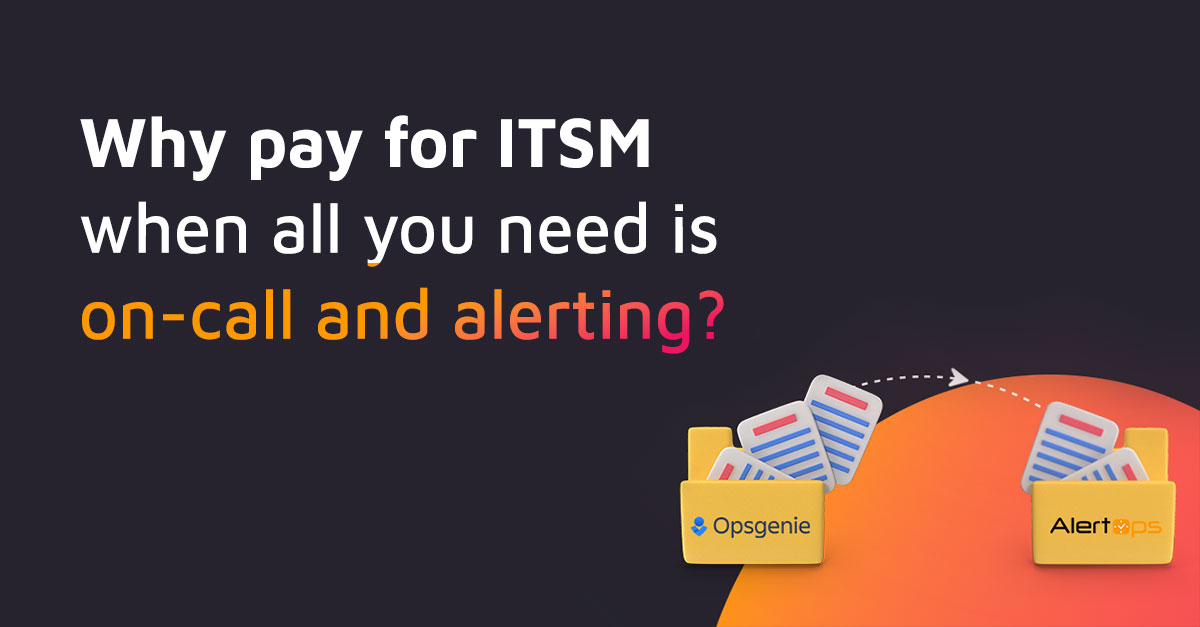IT operations management involves the administration of technology applications and components across an enterprise.
For effective IT operations management (ITOM), you must prioritize capacity management, security, availability, and cost-control of all IT infrastructure and assets. Yet, doing so can put a strain on your enterprise.
At AlertOps, we offer a major incident management and response platform designed to help your enterprise manage its IT operations.
Effective ITOM requires an enterprise to have the tools necessary to manage the capacity, performance, provisioning, and availability of its IT environment. To streamline ITOM, an enterprise typically employs IT operations managers who are responsible for handling networks, storage, servers, and security across its IT environment.
IT operations managers may have processes and systems in place, so they can track IT performance. They may also retrieve IT metrics, craft reports, and search for ways to drive continuous improvement.
What are the functions of IT Operations Management?
IT operations managers are responsible for the following ITOM functions:
1. Network Infrastructure Management
IT operations management managers ensure all equipment necessary to provide internal and external communications for an enterprise works properly. They are responsible for setting up remote access networks, managing telephone systems, regulating communications with external servers, and ensuring networks remain secure.
2. Help Desk and Computer Operations
IT operations management managers handle help desk services, including incident response and request fulfillment. They are responsible for scheduling and managing data back-ups, keeping stakeholders up to date about incidents, creating and provisioning user profiles and system access, and developing and implementing a disaster recovery strategy.
3. Server and Device Management
IT operations managers administer servers, devices, and other network endpoints. They manage servers that host a wide range of applications and maintain, patch, and upgrade servers as needed. In addition, IT operations managers provision desktops, laptops, and other devices to users and ensure that applications have access to sufficient storage space, so they can function correctly.
IT Operations Management (ITOM) vs. IT Service Management (ITSM)
On the surface, ITOM may sound similar to IT service management (ITSM). But, there are notable differences between the two.
ITOM emphasizes monitoring and controlling IT services and infrastructure. In doing so, an enterprise can employ IT operations managers who can execute routine tasks to support the operation of applications, services, and hardware components.
ITSM refers to activities required to create, deliver, support, and manage the lifecycle of IT services. Effective ITSM allows an enterprise to standardize processes for IT delivery and documentation. It can also help an enterprise lower its IT costs and generate actionable IT insights.
Ultimately, ITOM and ITSM are interrelated. Whereas ITSM involves IT services development, delivery, and management, ITOM emphasizes the use of processes and systems to manage IT operations. If your enterprise prioritizes ITOM and ITSM, it is well-equipped to optimize the value of its IT infrastructure and assets.

What are the common IT Operations Management challenges?
1. Limited Visibility
IT operations teams require visibility into IT architecture, so they can quickly identify and resolve operational and security issues. However, legacy software typically provides limited visibility into IT architecture. This can make it tough for IT operations teams to implement the proper controls to manage IT architecture across a broad assortment of systems and applications.
2. Disparate Technology and Systems
An enterprise may use a combination of on-premise and SaaS applications that function independently of one another. As such, an IT operations team must manage each application separately, which can increase an enterprise’s ITOM costs. This can also hamper an IT operations team’s ability to quickly and effectively mitigate IT issues.
3. Scalability
If an enterprise requires a new IT service, it can be exceedingly difficult for an IT operations team to implement and maintain it. This is due to the fact that enterprises often lack processes and systems to seamlessly integrate a new service across all departments.
IT Operation Management tips for Enterprises
There are several things that ITOps teams can do to optimize ITOM, including:
1. Use Data to Identify Common IT Problems
Collect data relating to IT incidents. This allows ITOps teams to identify common problems and find ways to alleviate them. Over time, ITOps teams can leverage data to streamline ITOM and ensure their enterprise can avoid significant outages.
2. Maintain Consistent Communication
ITOps team members should maintain consistent communication, so they can monitor and eliminate IT issues in their early stages. Ongoing communication enables ITOps team members to consistently work together to find ways to get the most value out of their ITOM processes and systems, too.
3. Focus on Automation
Technology is available to help ITOps teams automate everyday processes and systems. By using this technology, ITOps teams can improve efficiency and minimize the risk of human errors that otherwise can lead to IT issues.
With AlertOps, IT operations managers can automate incident management. Thus, if an IT issue arises that can cause downtime or service interruptions, AlertOps ensures IT operations managers and other stakeholders can identify and address the problem right away. This ensures an enterprise can avoid lengthy, expensive outages and maximize its uptime.



